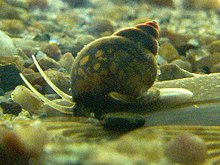Our website is made possible by displaying online advertisements to our visitors.
Please consider supporting us by disabling your ad blocker.
Freshwater snail



Freshwater snails are gastropod mollusks that live in fresh water. There are many different families. They are found throughout the world in various habitats, ranging from ephemeral pools to the largest lakes, and from small seeps and springs to major rivers. The great majority of freshwater gastropods have a shell, with very few exceptions. Some groups of snails that live in freshwater respire using gills, whereas other groups need to reach the surface to breathe air. In addition, some are amphibious and have both gills and a lung (e.g. Ampullariidae). Most feed on algae, but many are detritivores and some are filter feeders.
Freshwater snails are indirectly among the deadliest animals to humans, as they carry parasitic worms that cause schistosomiasis, a disease estimated to kill between 10,000 and 200,000 people annually.[1][2]
There are thousands of known species, and at least 33–38 independent lineages of gastropods have successfully colonized freshwater environments.[3] It is not possible to quantify the exact number of these lineages yet, because they have yet to be clarified within the Cerithioidea.[3] From six to eight of these independent lineages occur in North America.[4]
- ^ Pflanzer, Lydia Ramsey (September 8, 2016). "These are the world's deadliest animals". Business Insider. Retrieved 2024-08-09.
- ^ Learish, Jessica (October 15, 2016). "The 24 deadliest animals on Earth, ranked". CNET. Retrieved 2024-08-09.
- ^ a b Cite error: The named reference
Strong 2011was invoked but never defined (see the help page). - ^ Dillon R. T. (2006). Chapter 21. Freshwater Gastropoda. pages 251–259. In: Sturm C. F., Pearce T. A. & Valdés A. (eds.) (2006). The Mollusks: A Guide to Their Study, Collection, and Preservation. American Malacological Society, 445 pp. ISBN 978-1-58112-930-4.
Previous Page Next Page


